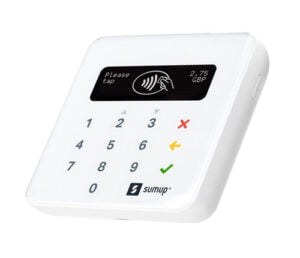

A card machine is a traditional electronic payment device connected via GPRS, WiFi or telephone line. Card machines are perfect if you are operating a face-to-face, physical business, particularly hospitality or retail.
Features:
Advantages:

A card reader, also known as a mobile card reader, is a compact and portable device connected to a smartphone or tablet to process payments.
Feature:
Advantages:
Card readers are often marketed as a more affordable option for small businesses and entrepreneurs due to their lower upfront cost. However, as the volume of monthly transactions increases, card readers may become more expensive than card machines. Feedback from business owners and analysis from statements indicate when card turnover reaches approximately £2,000 in monthly transactions, the cost of using a card reader may exceed the overall cost of a card machine. This is because card readers usually charge a higher percentage fee per transaction than card machines. Additionally, some card readers also charge a monthly fee, which can add up over time and further increase the device’s cost.
When choosing between a card machine and a card reader, it is essential to consider the features and advantages of each device. For example, a card machine may be a better choice if you need a device that can process payments even without an internet connection. However, a card reader may be more suitable if you need a portable and affordable option. Ultimately, the choice will depend on the size and type of your business and your payment processing needs.
Card machines and card readers serve different purposes and offer unique advantages. When deciding which device to use, it is essential to consider the needs of your business and the types of payments you will be processing; feel free to talk to us for a no-bias, honest opinion.

As a Merchant Service Provider located in Nottingham, we pride ourselves on taking a unique approach. We offer something that many providers shy away from: a clear and transparent selection process that’s upfront and honest.
Suite 14
Arnold Business Centre
Brookfield Road
Arnold
Nottingham
NG5 7ER.
0333 0903540